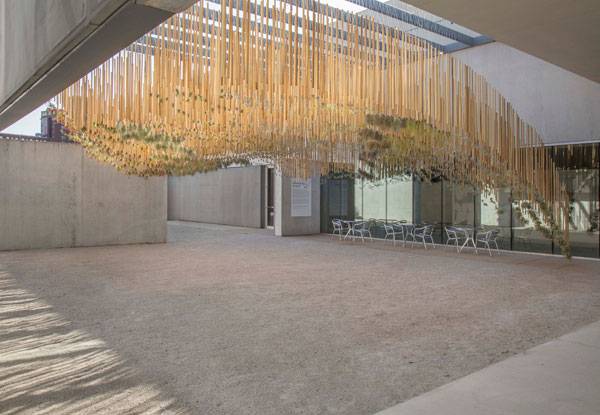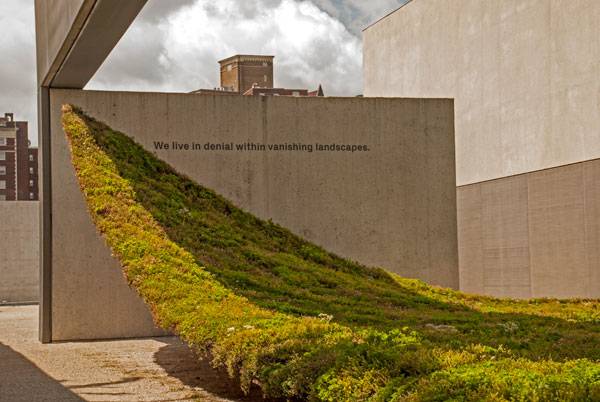Article by Emily Sinclair – Green Air, by Nomad studio, located in the Contemporary Art Museum of Saint Louis. Plants are key indicators in an ever-changing world. Plants and the ecosystems they inhabit are accustomed to working out problems within their own means. But as our human population grows, the strain on these environmental resources also grows – to a point in which the ecosystems are struggling to deal with all the pressures and pollution internally. Many landscape architects and landscape architecture firms are concerned with maintaining or returning the balance to these ecosystems. Nomad Studio of New York City is one of them. Its latest project, Green Air, showcases this dialogue well. Green Air was recently on display at the Contemporary Art Museum of St. Louis (CAM).

Green Air. Photo credit: Alise O’Brien
Green Air
Before delving into Green Air though, I would like to introduce you to another project by Nomad. This project, named Green Varnish, was a structure comprised of a wooden frame and plants placed close together, creating a green carpet that seemingly floated in the middle of the courtyard at CAM. Despite its immense occupation of the middle of the courtyard, it sat in the background, like a ghost. Its presence was one of quiet desperation, paired with the words “We live in denial within vanishing landscapes.” It depicts the struggle our strained landscape feels as we ignore or mismanage the problems associated with climate change and an increasingly global world. It’s important to first describe this project, as Green Air was installed as Part Two of this show.

Green Varnish. Photo credit: Sarah Rothberg
How to Put it Into Words
As a single installation, Green Air can be described as ethereal and mesmerizing. The gallery’s website describes the work as being comprised of “four-foot-long poplar sticks hung at varying heights, moving together in the wind and functioning as a monumental aerial garden.”

Green Air. Photo credit: Alise O’Brien
In describing the installation’s impression on the space, the gallery description goes on to say, “The installation transforms the surrounding gray concrete and glass environment into a natural and organic setting. Surviving on light and air alone, the Tillandsia function as a bio-indicator, speaking to the pollution pervasive in a man-made environment. Nested within the courtyard, this immersive hanging garden surrounds the visitors with unexpected beauty in a surprising location.”

Green Air. Photo credit: David Johnson
Landscapes and our Fortune
As a stand-alone installation, Green Air makes a strong statement about how the landscapes surrounding us can be fortune tellers. The effects of our pollution show up in these environments long before they are reflected in our daily lives. Let’s turn back to the relationship to Green Varnish. For as strong a statement that Green Air makes alone, Nomad reminds us that the two together create “a dialogue in form, material, time, and space”. Green Air has all of the pieces of Green Varnish, reused and repurposed; it occupies the space once left empty by Green Varnish.

Green Air. Photo credit: David Johnson
Trailing Plant Used Throughout
Wood slivers, previously from the frame, hang from the courtyard’s steel canopy. Tillandsia plants are suspended from the ends, creating a new carpet, one that drapes over the people in the courtyard, rather than alongside them. Green Air exposes the potential of the space Green Varnish once occupied, and this revealed space is well used by museum attendees, as they lounge under the plants in the air at little bistro tables. This kinetic sculpture moves with the wind, tillandsia and wooden sticks moving gently, creating a shifting shadow on the floor of the courtyard. As it shifts, it becomes a soothing, peaceful show to watch as it undulates in the space above everyone’s heads.

Green Air. Photo credit: David Johnson
The Results of Two Installations
Together, these two installations built a two-act play, commentating on how common it has become to live in denial as our landscapes struggle. While Green Varnish covered and hid, Green Air exposes. Where Green Varnish was is now revealed in the negative space underneath the many dangling Tillandsia. It is exactly this, though, that brings home the point that Nomad seems to be making: That landscapes are forced to change and, as a collective, people are comfortable with ignoring the possible ramifications of this and instead choose to only react to the changes, whether they be good or bad.

Green Air. Photo credit: David Johnson

Green Air. Photo credit: Sarah Rothberg
Full Project Credits For Green Air :
Project: Green Air Location: Contemporary Art Museum of Saint Louis (CAM). Landscape Architects: Nomad Studio. Date of Construction: Summer 2016 Size: 200 square meters Consultants: LIA Engineering. Installation Team Jessi Cerutti & Caleb Hauck. Molly Brennan, David Burnett, Key Chen, Ryan Doyle, Zac Farmer, Joshua Gann, Matthew Hannon, Emily Keefauver, Eric Kobal, Marianne Laury, Chris Lucas, Eric Repice, Adrienne Sandusky, Bret Schneider, Margot Shafran, Laura Schatzman, Jonathan Watt, Jamie Wiechens, Bin Yang, Eileen Zhang. Maintenance Team: St. Louis Master Gardeners. Credits: All graphics courtesy of Nomad Studio and credited to their photographers, including a copyright in front of their names. Recommended Reading:
- Becoming an Urban Planner: A Guide to Careers in Planning and Urban Design by Michael Bayer
- Sustainable Urbanism: Urban Design With Nature by Douglas Farrs
- eBooks by Landscape Architects Network
Article by Emily Sinclair
Published in Blog










